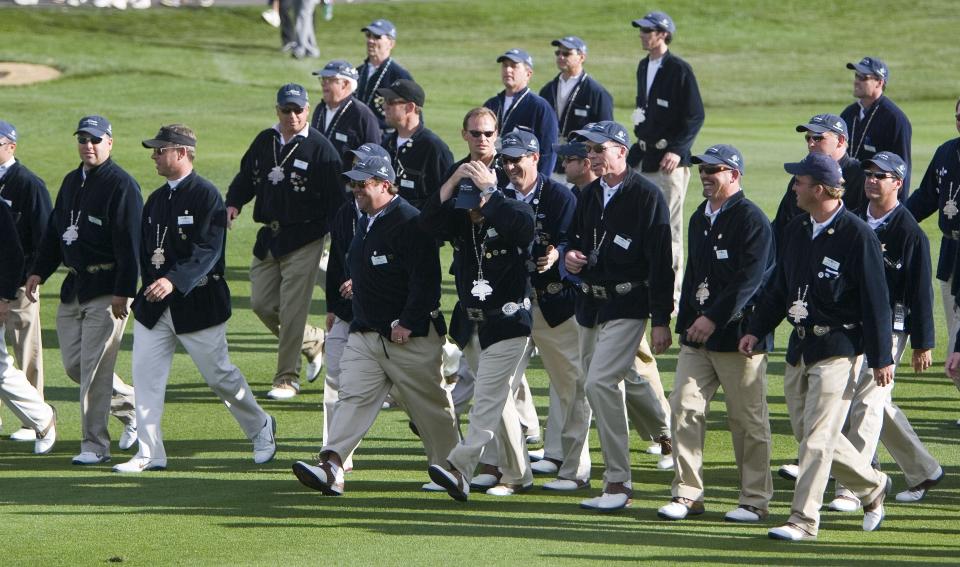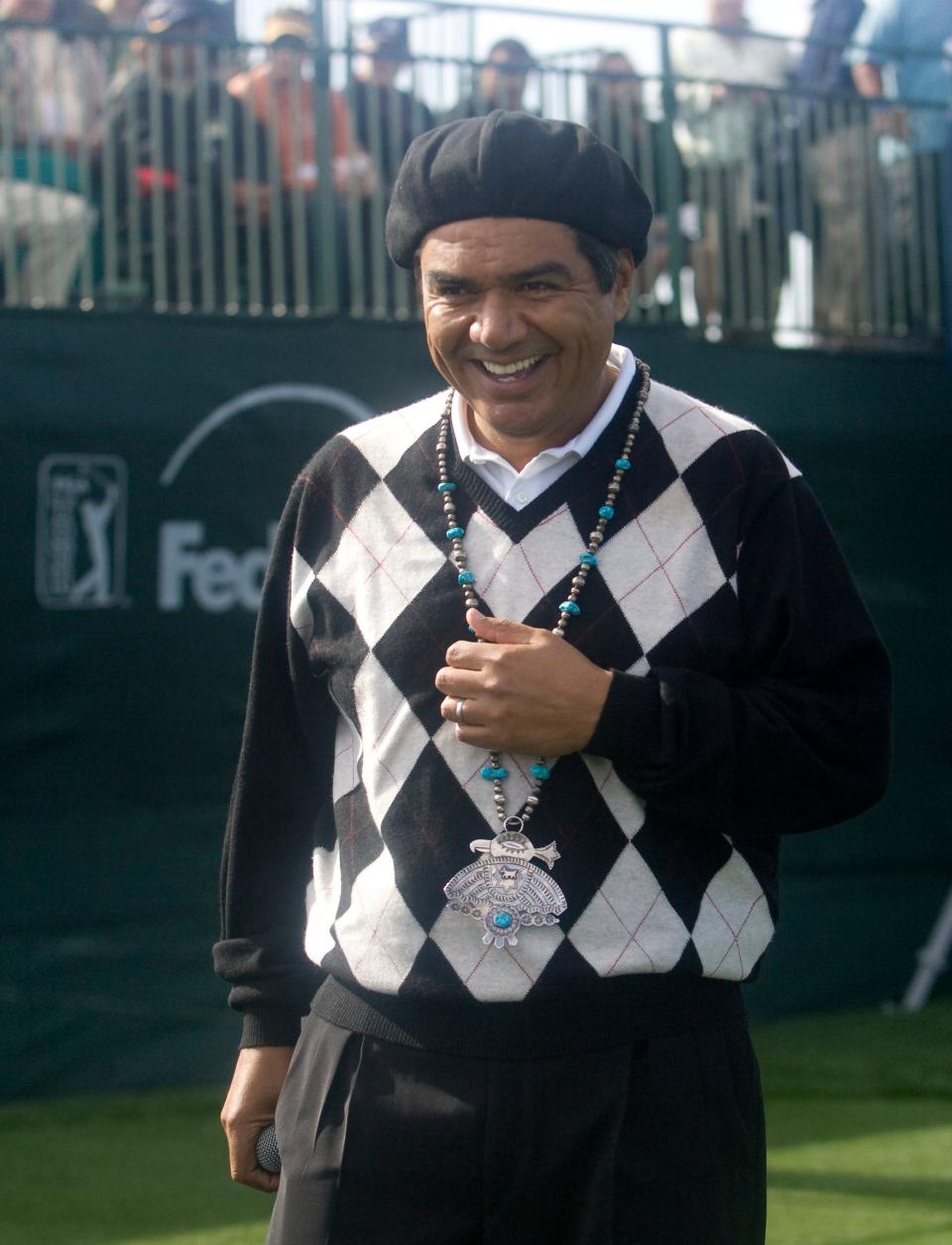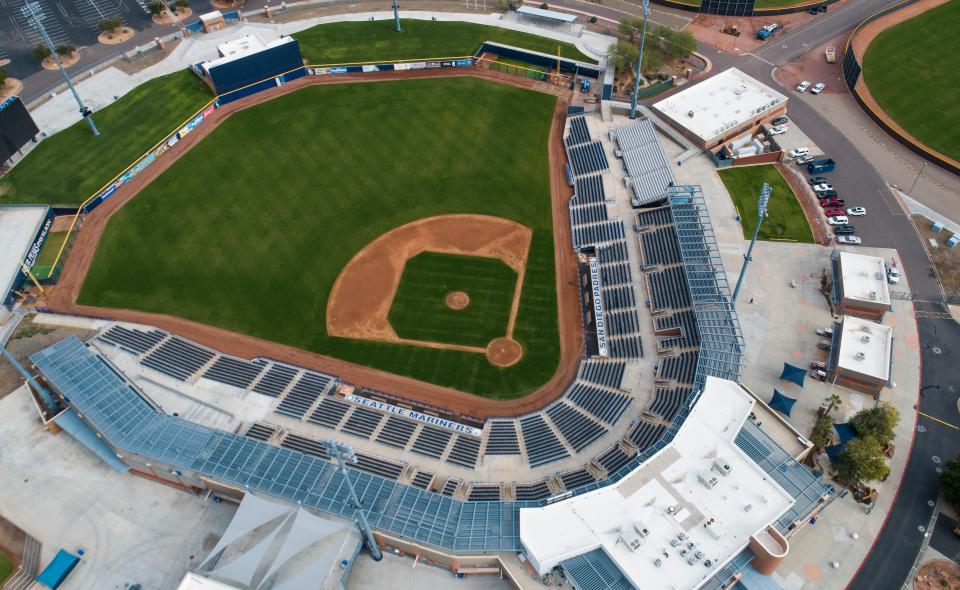'Dress up and play Indian': Why do civic groups use Native American symbols?
- Oops!Something went wrong.Please try again later.
In 1937, Phoenix was a small city isolated in the middle of the Arizona desert with a population of less than 50,000 people who, like the rest of the nation, were struggling to recover from the Great Depression. Some banks had failed, businesses had closed, and many workers had lost jobs.
Searching for a way to attract tourists and boost the economy, the Phoenix Chamber of Commerce came up with a catchy nickname for the desert oasis — Valley of the Sun — and tapped five business leaders to form a committee to promote the area through a sporting event.
That committee became the Thunderbirds, and one of its first inductees, Barry Goldwater's brother Bob Goldwater, suggested sponsoring a golf tournament.
That small tournament started during the Great Depression is now the wildly popular WM Phoenix Open, among the most attended PGA tournaments in the world. The Phoenix Open draws hundreds of thousands of fans every year, generates nearly half a billion in revenue annually, and raises millions for charity, including $14.5 million in 2023 alone.
While the golf tournament has evolved over the nearly nine decades since it was founded, the Thunderbirds organization continues to cling to symbols taken from Indigenous cultures that academics and advocates say are outdated and offensive to Native Americans.
The Thunderbirds name was chosen in 1937 because the emblem of the Phoenix Chamber of Commerce was a Thunderbird derived from American Indian symbols, said Thunderbirds Executive Director Chance Cozby.

"The Thunderbird is often a symbol of strength and power and has importance and meaning to many Indigenous peoples," Cozby said in an email. "Our desire is to honor the symbol of the Thunderbird through our charitable giving and continued investment in Arizona."
But critics consider the use of Indigenous symbols by non-Native groups a theft of Indigenous culture that should end. They say that contrary to these groups' claim to be honoring Native peoples or "appreciating" Native culture, as the leader of another Phoenix-area civic group said, the use of Indigenous symbols by non-Native groups without permission or input is an insult to Native people that is also psychologically harmful.
"Native people have always been a resource. Never has there been a positive relationship. We've always been something to take from, whether it be the land, water, children, our image," said Amanda Blackhorse, a member of the Navajo Nation and an advocate for Indigenous people.
Blackhorse has fought against the use of racist names and mascots by professional sports teams. Under pressure from Native advocates, many sports teams have dropped the use of Native American names and mascots, including some during the racial reckoning sparked by the murder of George Floyd. But civic groups have not faced the same scrutiny, and many continue to use names and symbols appropriated from Indigenous peoples, Blackhorse said.
"If you are not part of that community, you have no business appropriating and using Native peoples' image," Blackhorse said.
The name Thunderbirds is taken from a legendary spiritual creature believed by many Native American tribes to have wings so big they sound like thunder when flapped. The civic group also borrows an Indigenous-inspired symbol of a thunderbird as its official emblem. And for decades, the Thunderbirds have dressed up in Indigenous-inspired tunics, belts and silver pendants during special events, including the Phoenix Open.

Photos on the Thunderbirds website show current and past members wearing velvet tunics reminiscent of Diné/Navajo clothing, large silver Thunderbird pendants hanging from chains around their necks, and silver and turquoise Navajo-style concho belts wrapped around their waists.
The Thunderbirds leader is called "The Big Chief" and the 55 "active members" who lead the group are known as the Thunderbird Council. They are all, or mostly all, men, most of them white, based on photos posted on the group's website. The group does not collect data on members’ gender, race or ethnicity, Cozby said.
"All Thunderbird activities and events are the prime responsibility of these Active Thunderbirds and are under the watchful eye of the Big Chief and Thunderbird Council," the Thunderbirds' website says.
The irony of the civic group's use of the Thunderbirds name and motif is that it makes Indigenous people feel unwelcome, said David Martinez, a professor of American Indian Studies at Arizona State University, in an email. He belongs to the Akimel O'odham and Hia Ced O'odham peoples, who have inhabited the Phoenix area since time immemorial.
The group, Martinez said, has turned the ancient thunderbird symbol into a "mere logo and uniform, and reduced the thunderbird image to an "icon of white male wealth and power," Martinez said. "In fact, these thunderbirds have turned an Indigenous cultural symbol, which the Lakota, for example, called the Wakinyan, into something completely alien to Indigenous people: a sign of the white man's social status."
The Greater Phoenix Chamber of Commerce stopped using the Thunderbirds symbol decades ago, said president and CEO Todd Sanders. The chamber now uses an upward-pointing arrow logo that "symbolizes a focus on the future and growth of businesses in Arizona," Sanders said.
Several civic groups in Arizona appropriate Native culture
The Thunderbirds is the most prominent local civic group tied to a major sporting event that uses names and other symbols based on Native culture. But other local groups, including the Tempe Diablos, the Surprise Sundancers and the Mesa HoHoKams, also have names that appear inspired by Native culture or could be considered culturally insensitive. These organizations help host spring training games for Major League Baseball teams in the Phoenix area.
The Mesa HoHoKams are named after the Indigenous people known for the sophisticated network of canals they dug in the Phoenix area. They are the ancestors of the present-day O'odham people. The HoHoKams civic group dates to the early 1950s, and helps host Cactus League games for the Chicago Cubs and Oakland Athletics.
Martinez said he had not previously heard of the Mesa HoHoKams. "Needless to say, my jaw hit the ground when I looked at the team's web page," he said.
The group's website shows leaders also wearing thunderbird pendants around their necks. The president is nicknamed "Big Ho," and the vice president "Little Ho," according to the group's website.
"The 'HoHoKams' are a true anachronism, a throwback to the early 20th century, when it was acceptable to dress up and play Indian at fraternity lodges," Martinez said. "It's hard to believe that this kind of cultural insensitivity still happens in this day and age."
The name "HoHoKams" does not make grammatical sense because "Hohokam" or, more accurately, "Huhugam" is already in the plural, Martinez said.
The singular word is "Huhug," Martinez said.
Regardless, "there is no evidence that the team organization knows anything about the people, the ancestral O'odham, whose name they've appropriated," Martinez said.
Martinez said he hopes the Mesa HoHoKams will take the issue seriously. He suggested the group meet with O'odham elders, tribal historic preservation officers, or political leaders to create "a healthier and more respectful relationship with the O'odham."
"The city of Mesa, after all, is a part of the Akimel O'odham historic homeland," Martinez said.
Cultural appropriation is damaging to Indigenous people, research shows
Kathryn Shanley said her "gut level response" to photos on the Thunderbirds website of members dressed in Indigenous-inspired clothing and jewelry was old photos of students at elite universities dressing up in costumes and getting drunk at parties.
"You know, just very funny old boys club stuff," said Shanley. She's a retired professor of Native American Studies at the University of Montana and has written about the theft of Native American culture by non-Natives. She belongs to the Nakoda Fort Peck Tribes of Montana.
Shanley said it is often not easy to persuade organizations to stop using Native symbols because they often don't understand why it's offensive to Indigenous peoples.
"The people who engage in appropriation of other people's cultural traditions do it for their own reasons, primarily, and they often do not understand even a local history that they should understand" about how Native people have been oppressed and continue to be oppressed, Shanley said.

Sports teams and other organizations often use Native symbols to convey "male prowess," Shanley said. The viewpoint is rooted in colonial attitudes of Native Americans as fierce warriors that needed to be vanquished, she said.
"In the conquering of Native people, we have assumed their fierceness. We have internalized all that was good about them, and we are one better," Shanley said.
It's also ironic that the adoption of Native symbols by civic organizations often dates back to a time when Native American children were being taken from reservations and sent to boarding schools as part of a policy of forced assimilation that followed policies of extermination, Shanley said.
"It is a cultural appropriation of perceived power and a vindication of a kind of nasty colonial history that actually was genocidal in many respects," Shanley said. "It's called honoring, but it's dishonest. It doesn't own the most nasty aspects of that experience."
Shanley also wondered who benefits from the money raised by the Thunderbirds and other civic groups that use Native symbols.
"It would be good to know how much connection they have at all with any Native-need group or student population," Shanley said.
Research shows that the use of Indigenous symbols by non-Native groups is psychologically harmful to Indigenous peoples, said Stephanie Fryberg, a psychology professor and director of the Research for Indigenous Social Action & Equity Center at Northwestern University. She is a member of the Tulalip Tribes of the Pacific Northwest.
"The misrepresentation of Native and Indigenous peoples in this country continues the long history of Native erasure and dehumanization" that is central to the founding of the U.S., Fryberg said in a written statement.
Studies conducted by the center show that 65% of Americans view Native peoples as "people of the past," Fryberg said. As a result, Americans are more likely to minimize racism and discrimination experienced by contemporary Native Americans and less likely to work to reduce discrimination against them, she said.
Exposure to discrimination that stems from erasure and dehumanization is harmful to the psychological well-being of Native Americans, leading to greater distress, anxiety, depression and suicidal ideation, she said.
"It should come as no surprise that the majority of Native Peoples, especially Native Peoples who are highly identified and engaged with their communities, are against the use of Native mascots" and are offended by behaviors of non-Native people who engage with these mascots, Fryberg said.
Civic groups respond to criticism of cultural appropriation
Thunderbirds: The Thunderbirds and its charitable organization have made contributions to Native groups and organizations that support them, said Cozby, the executive director.
Cozby said the Thunderbirds, for instance, recently collaborated with the nonprofit Native American Connections to support an affordable housing project.
"We are grateful for our strategic partnerships with many of Arizona's Tribal Nations and are always open to feedback to strengthen those relationships," Cozby said.
Mesa HoHoKams: Mark Fullerton, president of the Mesa HoHoKams, said the group's name was chosen to honor the "hard-working industrious people who built the original canals" in the Mesa area.
"It's not been appropriation of the culture but is appreciation of that culture," Fullerton said. "The Mesa HoHoKams' intent was respectful and sought to honor the original Hohokams by the good work the Mesa HoHoKams try to do."
Members of the group do not "dress up and play Indian" at a lodge, Fullerton said, as suggested by Martinez, the ASU professor.
The group was established to bring spring training to Arizona but has expanded to support nonprofits that provide food, shelter, and mental health assistance, he said. The group also sponsors invitational high school track and swim meets.
"Over the years we have donated millions of dollars to the East Valley community. Mesa HoHoKams is made up of a diverse group of volunteers who generously give thousands of hours annually to the community," Fullerton said.
Surprise Sundancers: The Sun Dance is a spiritual ceremony practiced by many Native tribes. Jay Hicks, president of the Surprise Sundancers, said the group doesn't know the history of the name's origin or if it is a reference to Indigenous culture.
The nonprofit is the official spring training volunteer organization of the Kansas City Royals and Texas Rangers and raises money for student scholarships.
"Records indicate that the name has been in place since the 2002 filing of the organization," Hicks said in an email.
Hicks said the group's 750 volunteer members are known for their "bright yellow shirts versus any Native culture reference."
"We appreciate you bringing this to our attention as a possible concern to fellow citizens and Native cultures," Hicks said.

Tempe Diablos: The Tempe Diablos is a nonprofit volunteer group formed in the late 1960s. It helps host spring training games for the Los Angeles Angels and raises money for scholarships, underserved populations and youth.
The group's president, Greg Garcia, second vice president, Vincent Vasquez, and secretary/treasurer, Arnold Mejia, are Latinos.
The group's logo is a cartoon of a red devil wearing a large sombrero, a common stereotype of Mexican culture.
"We embrace the community we serve and its rich southwestern heritage," the group said in a written statement.
The group also recently adopted "an additional, more contemporary logo."
"We recognize the importance of our organization's brand and that it is one of the most visible ways we connect with our community," the statement said.
Reach the reporter at daniel.gonzalez@arizonarepublic.com.
This article originally appeared on Arizona Republic: Should Arizona civic groups stop using Native American symbols?

